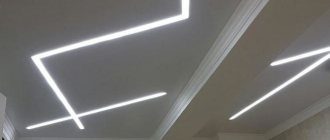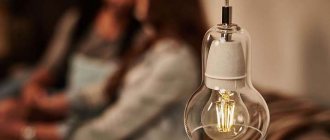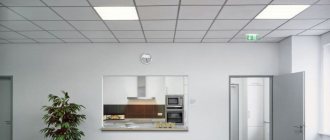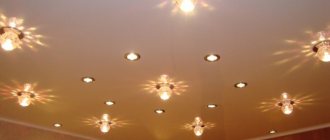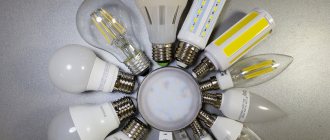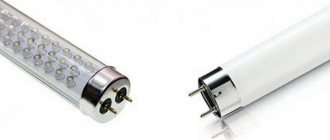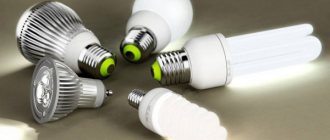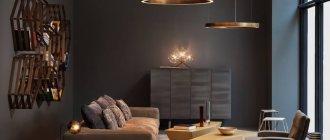The choice of a table lamp must be made taking into account a number of factors, since the equipment affects comfortable work. It is especially important to choose a high-quality model for those who spend a lot of time at their desk. If a lamp is needed for a child, then any mistakes and miscalculations are unacceptable, as this can worsen vision.
Futuristic xiaomi mi smart led lamp
What is LED Table Light
LED is a semiconductor light source. It emits light when electric current passes through it. Electrons in a semiconductor recombine with electron holes, then releasing energy in the form of photons. This is called electroluminescence.
The color of the glow is determined by the energy required for electrons to cross the band gap of the semiconductor. White light is produced by the interaction of multiple semiconductors or a layer of light-emitting phosphor on a semiconductor device.
It is worth considering that a desktop device, even based on super-bright diodes, is an additional source. It should not act as the main light source in any way. For complete lighting, it is worth using high-quality LED lamps for interior lighting or lamps built into the wall.
Power
What power should I choose? Initially, ophthalmologists developed recommendations for ordinary incandescent lamps.
Their power should not exceed 60W.
Why exactly so much? With a power greater than 60W, the incident light is reflected very well from the white paper of notebooks, books, and albums.
The child experiences discomfort. I want to move the notebook further away or lift the lamp higher. As a result, vision becomes strained.
The optimal height of the light source to the table surface is 35 cm.
And if there is a computer on the table, then the lamp should rise above it, and not be located on the side. Otherwise, glare cannot be avoided.
1 of 3
Based on this, the recommended height of the leg is determined - 40-50cm.
Don’t even take into account the cute and funny doodles.
But we agreed that it is not advisable to use sources in the form of incandescent light bulbs. How to transfer this estimated 60W to LED models?
There are tables of correspondence between different types of lamps in relation to conventional ones. Take advantage of them.
According to these tables, LED models with a power of 6-8W will be sufficient for a student’s desktop.
However, not all LED lamps are “equally useful”. The difference in lighting efficiency with the same power can reach almost 40%.
Therefore, here they focus primarily on such a parameter as the illumination of the working area. What is it, how is it calculated, how not to confuse luxes with lumens, and what they all “eat” with, read in detail in the article below.
So, for a schoolchild or student’s desk, the recommended illumination should be from 300 to 500 Lux. And the luminous flux ranges from 400Lm to 700Lm.
If your budget allows, then brands with adjustable brightness and a built-in dimmer would be an ideal option.
With the same lamp, it will be comfortable to work both with books and notebooks, and at the computer. When working with paper products, reduce the power, and when moving to the monitor, add it.
If the model is not dimmable, then when purchasing in a store, take with you a blank sheet of white A4 paper. And place it under the switched on lamp.
If you won’t be blinded, you can safely buy such a lamp and a light bulb for it.
Where and how it is used
Table lamps with super-bright diodes are designed to illuminate the surface of the desktop. LED desk lamps for schoolchildren are one of the most common types. In addition, there are many varieties of LED table lamps for desks, classrooms, and offices. Devices are also necessary for sewing and knitting.
A wide variety of different table lamps allows you to use them as interior decoration.
Shape and material of the lampshade
It is not recommended to choose table lamps with shades that are too complex in shape - this is impractical. The optimal design of the lampshade is in the form of a trapezoid. The trapezoidal lampshade allows you to most effectively distribute the flow of light and create comfortable lighting for children's eyes.
The color of the lampshade should not be too bright so as not to irritate the eyes. It is best if the lamp is of soft pastel colors.
Important! The surface of the lamp should not be glossy. This material produces glare, so you need to choose a lighting fixture with a matte surface.
An important issue is the material from which the lamp is made. Preference should be given only to high-quality plastic. Cheap plastic will not withstand elevated temperatures and sooner or later will melt. You should not purchase metal lampshades, as it is easy to get burned on them.
Design Features
LED lamp circuit IC1 BP5041; AC/DC converter.
The converter is connected to a network with a voltage of 220 V. At the output, it provides a voltage of 5 V, taking into account a current of 100 mA.
The connection to the network occurs through a rectifier made of a super-bright diode D1, as well as a capacitor C3. Capacitor C2 and resistor R1 are responsible for eliminating impulse noise.
Full protection of the device is provided by fuse F1. Its nominal value should not be higher than that indicated in the diagram. Smoothing of voltage ripple at the output is performed by capacitor C3. The output voltage has no galvanic isolation from the network. It requires strict adherence to safety precautions during its production. In this scheme its presence is not necessary.
Capacitor C2 must be made of ceramic or film materials. For capacitors C2 and C3, the operating voltage must be no less than 450 V. The resistance of resistor R1 must be in the range from 10 to 20 Ohms, which ensures normal operation of the converter.
The operation of such a converter makes it possible not to use a step-down transformer. This significantly reduces the size of the entire device.
One of the characteristic features of this circuit is the presence of a built-in inductive coil. This allows you to significantly reduce the size of the circuit board, as well as the number of attached parts.
Any diode D1 with a reverse voltage of at least 800 V and a rectifying current of approximately 500 mA is suitable. For example, a 1N4007 diode is suitable for this.
Types of table lamp designs can be divided into two groups:
- Classic. They are characterized by a flat platform base. This type of device has a flexible part from the base to the lampshade.
- Clamp. These are LED table lamps that are mounted to the table or mounted on the edge of the tabletop thanks to a screw clamp. This type has hinged structures that adjust the position of the device.
Glow color
Another important parameter is the color of the glow. In work areas of offices or offices, a cool shade is preferable.
It is said to greatly improve concentration and productivity.
However, a warm shade is safer for a child’s retina.
This glow corresponds to temperatures from 2700K to 3200K.
Temperature data can always be found either on the light bulb box or on its body.
Always pay attention to color. Sometimes he can present unpleasant surprises.
Technical characteristics of the LED table lamp
The characteristics largely depend on the model and manufacturer.
- The supply voltage is on average from 12 to 220 V. Most often, a 12 V DC network is used, but thanks to powerful drivers it is possible to use the lamp in an alternating voltage of 220 V.
- Power consumption ranges from 3 to 28 W. The power may not differ much from, for example, bathroom fixtures.
- The luminous flux varies from 70 to 85 lm/W. For luminaires for suspended ceilings, this figure will be higher and will be 90 lm/W. For every watt, the diode produces almost 10 times more luminous flux than a conventional incandescent lamp.
- Colorful temperature. Its indicator varies from 2700 K to 7000 K. Thanks to LED crystals, the following lighting color options are available: warm white (2700-3200 K), daylight (3500-5000 K) and cool white (5000-7000 K). This characteristic is displayed not only on the packaging, but also on the lamp itself.
- Light is emitted in one direction and in a small sector. For magnification, frosted polycarbonate diffusers are used. You can also use several diodes aimed at different angles.
- Brightness adjustment is adjusted using a dimmer (dimmer), if available. It produces power in the form of pulses. The lower the pulse frequency, the dimmer the diode; the higher it is, the brighter it is. The blinking frequency is not noticeable as it is around 200-300 kHz.
- LED light sources can operate at temperatures from -40 to +40. This makes it possible to use them instead of other, more harmful, sodium, gas-discharge or mercury lamps.
- Basically, the protection level is IP 54 - a high level of protection against dust, as well as protection against rain and splashes.
Recommendations from ophthalmologists for selection and installation
Ophthalmologists say that 70% of eye problems in schoolchildren occur due to improper desk lighting.
Basic recommendations from doctors:
- the best shape of the lampshade is trapezoid;
- optimal color – any tone of green;
- the best light source is an incandescent lamp;
- luminous flux color – 2700-3000 K.
A lampshade with a narrow base and wide edges illuminates the maximum area of the table. Green color relaxes the ciliary muscles of the eyes, which has a positive effect on vision.
The worst colors for a lampshade are orange and red, as they do not allow you to concentrate and excite you.
You can argue about light bulbs - high-quality LED ones are no worse than incandescent ones, even better, especially from a safety point of view.
What are the types?
By type of destination:
- LED desk lamps for work desk;
- office LED lamps;
- decorative lamps with fastening to the table.
By style:
- classic;
- modern;
- high tech;
- loft.
There is a classification based on the type of network connection:
- wired;
- wireless;
- both wired and wireless (2 in 1).
Table lamps can also have two different types of bulbs:
- removable;
- integrated.
The first type is a ready-made model with already installed super-bright diodes of a given power. If any of the diodes burns out, the entire device will stop functioning.
The second type of light bulb is directly screwed into the socket of the structure itself.
Type of foot inside the lamp
Today, stores offer a very wide selection of table lamps, both with simple incandescent bulbs and LED ones.
Classic luminescent energy-saving lamps, one might say, have outlived their time.
And not everyone is interested in demercurizing the premises if such a light bulb breaks.
Toxic mercury vapors in a children's room are not exactly what parents want for their children.
Therefore, discard such light bulbs immediately.
Advantages
- Long service life, which can amount to about 100,000 hours of continuous operation.
- Economical. LED light sources consume up to 20 times less electricity compared to classic incandescent lamps.
- No flicker.
- No pulsation.
- No glare.
- No overheating.
- Lack of infrared and ultraviolet radiation.
- Low temperature resistance.
- Environmental friendliness. These lamps do not contain mercury or other toxic elements.
- Focusing. The LED housing can also be designed to focus the light. Classic incandescent and fluorescent sources often require an external reflector to collect light and direct it in a way that is easy to use. More LED bodies require total internal reflection lenses. However, when a large amount of light is required, there are usually quite a few light sources that are difficult to focus or collimate towards the same target, which is not necessary with a single LED table lamp.
Light control
In the old days, such a question did not even arise for consumers. There was one way to control it - plug the plug into the socket. Manufacturers now offer various options, including:
- touch control;
- with dimmer;
- using a cord;
- push-button (on the body or on the stand).
What are the features? Lamps with touch control will really appeal to kids, because with a light touch of your finger on the touch screen you can not only turn the light on or off, but also adjust the intensity. Controlling lighting with a cord requires a sufficient length of this cord. It is necessary that it can easily reach the outlet; try to avoid using extension cords. But you don’t need one that’s too long either, because it will curl, get in the way, or break, which will lead to damage. Measure in advance the distance from the lamp installation location to the power source. The easiest way to control is with buttons. They can be located both on the platform and on the ceiling itself.
Flaws
- High price.
- Manufacturing defect.
- Sensitivity to mechanical influences. The vast majority of light bulb types are made from fragile or soft materials. In the event of an impact or fall, the required level of protection is not available.
- Sensitivity to tension. Electrical current and service life vary with small changes in applied voltage. Thus, they require a regulated current supply (usually just a series resistor for LED lights).
- Blue light pollution. Because ultra-bright cool white LEDs emit proportionately more blue light than conventional outdoor light sources such as high-pressure sodium lamps, Rayleigh scattering is wavelength dependent. This means that these types of LEDs can be more light pollutants than other light sources. The International Dark-Sky Association does not recommend the use of white light sources with a correlated color temperature above 3000 K.
- Gradual decrease in efficiency. The efficiency of LEDs decreases in proportion to the increase in electric current. The heating of the luminaires also increases with increasing current, which reduces the life of the diodes themselves. These effects place limitations on the current through the LED under high power conditions.
How bright should the workplace be?
To ensure that classes take place in a comfortable and safe environment, the workplace must be well lit. The lighting standards for workplaces are prescribed in the international standard EN12464-1. This indicator is measured in lux (lx). Thus, classrooms and reading tables should have an illumination of 500 lux, and art studios and drawing classes should have an illumination of 750 lux. To make it clearer, a bedroom with thick curtains has an average illumination of 200 lux, and a bright apartment on a cloudy day has 1000 lux. The illumination of the workplace with a table lamp depends not only on the characteristics of the device, but also on the height of the frame. The lower the light source is from the table, the higher the illumination. Keep this in mind when choosing a lamp.
How to choose
- The packaging must be undamaged, dry and clean.
- Correct spelling of the manufacturer's product name.
- Mandatory presence of a barcode and/or QR code.
- Availability of instructions and passport.
- Availability of all technical characteristics and parameters on the packaging, and/or in the passport, and/or in the instructions.
- Choosing a table lamp is quite an important process, since the level of vision depends on it, and LED-based lamps can provide a high-quality level of illumination without harming it.
A high-quality LED lamp is a functional addition to the desktop of both a schoolchild and an office worker, an assistant when reading and working at the computer. Making it possible to save on electricity, such a lamp often becomes a successful element of room design. It really has many advantages that can make life and work more comfortable. That's why it's so important to choose the right lamp.
Varieties
Table lamps differ from each other in many ways. They have a different appearance, differ in the specifics of operation, installation method, the nature of the lamp being installed and other indicators.
As for table lamps, they can either be attached to the edge of the table or be equipped with their own leg.
Those table lamps that have their own base and are simply installed on the table have a weighty base. Thanks to it, the device becomes stable and can function in any position. Among other things, manufacturers also now offer options for table lamps with the ability to adjust the light intensity. It is these lamps that help schoolchildren easily cope with homework of any complexity in a comfortable environment.
Today, the following types of table lamps are considered the most common:
- Classic is the most common. Available in a variety of colors and suitable for consumers regardless of their age.
- Clothespin lamp – stands out for its bright design and the presence of a built-in clock. Ideal for schoolchildren and allows them to concentrate on their studies and keep track of time without distractions.
- With a bending frame - it ensures proper lighting, and the frame allows you to install it in any position.
- With an original design - it has an unusual shape, colors and is a wonderful addition to the interior.
There are also many different lamps that differ in their appearance. Table lamps in the shape of an animal or favorite character are very popular among primary school students.
Light flow
The first question that arises when we choose a lamp is: how suitable it is for our specific needs, how much light it will give. We are used to equating the amount of light, or luminous flux, with the power of the lamp - how much energy it consumes. This is wrong, about the same as measuring the quality of gasoline by the speedometer. Watt is a measure of the amount of electricity a lamp consumes and depends on the luminous flux and the type of lamp. Luminous flux is measured in lumens (Lm/Lm); To understand how much light a light bulb will give, you need to look at this indicator.
For example, if a chandelier contains 12 LED lamps of 5 watts each, this will give a total of 60 watts, which is equal to one incandescent lamp of the same 60 watts. However, one 5-watt LED bulb produces 460 lumens, and one 60-watt incandescent bulb produces approximately 660 lumens. To compare power (watts) and luminous flux (lumens) of different lamps, you can use power tables for simplicity.
Too strong a luminous flux, that is, very bright light that is unpleasant for the eye, can cause a blinding effect. It is important to take this into account and leave the amount of light in the room that is comfortable for you. If a designer is working with an apartment, he should calculate the optimal light based on your needs, and not select a chandelier only by design. In order to save energy, it is often recommended to install a dimmer - a device that allows you to adjust the brightness of the light. In fact, this does not provide any savings: your light may be dimmed, but in fact the light bulb consistently consumes the same amount of energy. This means that the difference in electricity consumption will be insignificant - at best, 3-4% less, which in terms of money will not provide tangible savings.
Safety to use
Even such a common household appliance as a table lamp can pose a great threat if it is not made properly. Before purchasing, you should carefully inspect the product - check the wire, socket, switch. The seller must show the appropriate safety certificate. Even a light bulb in a table lamp can affect the health of a child’s eyes, either stimulating or reducing their performance. Therefore, you should not save money and buy the first lamp you come across. First you need to carefully study all the characteristics of the product. Then it will last a long time and will contribute to better learning.
Halogen lamps
Halogen lamps are equipped with a reflector. They also have an incandescent filament, but in addition the lamp contains halogen gas. They differ from incandescent lamps in that they provide 20% more illumination, and they operate for more than 2000 hours. The main types of sockets for halogen lamps are G9, G4, R7S, GU10.
Advantages of halogen lamps:
- More light
- Smaller in size, which allows you to create more compact or creative lamps with them.
Lamps with a GU10 base are the most commonly used lamps in spotlights. Together with them, most models of spotlights are produced, such as recessed, overhead, and furniture lamps. Models of unusual chandeliers, ceiling lamps, sconces and floor lamps are also common with halogen lamps. But still, the main use of such lamps is spot light.
Range
A study of the spectrum of conventional LED and fluorescent lamps revealed an effect on vision and human condition. Conventional LEDs contain a large amount of blue light at a wavelength of 450 nm, which does not allow the pupil to constrict normally. The pupil lets in a lot of blue light, which accelerates the deterioration of vision. High amounts of blue light reduce the production of the sleep hormone melatonin, which can weaken the immune system and affect other processes.
The Orion and Flora table lamps use new Korean Sunlike LEDs, which have a flat spectrum and do not have a large peak of blue light. The light obtained is as close as possible to natural sunlight in the spectrum.
Many smartphones have already implemented night mode and reading mode, which are used when there is no external lighting, the smartphone screen becomes the only source of light. In these modes, radiation in the blue spectrum is reduced, the image hue shifts to the warm part of the spectrum.
